jmeter接口自动化部署jenkins教程
首先,保证本地安装并部署了jenkins,jmeter,xslproc
我搭建的自动化测试框架是jmeter+jenkins+xslproc
---注意:原理是,jmeter自生成的报告jtl文件,通过xslproc工具,再结合jmeter自带的模板修改,自带模板目录如下,最终将测试结果报告转化为html格式
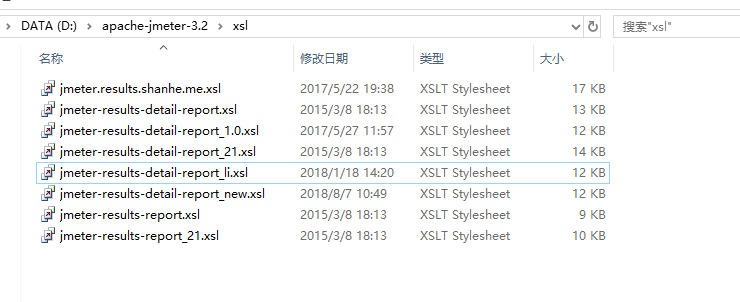
1.jenkins新建一个任务,选择“构建一个自由风格的软件项目”,点击OK
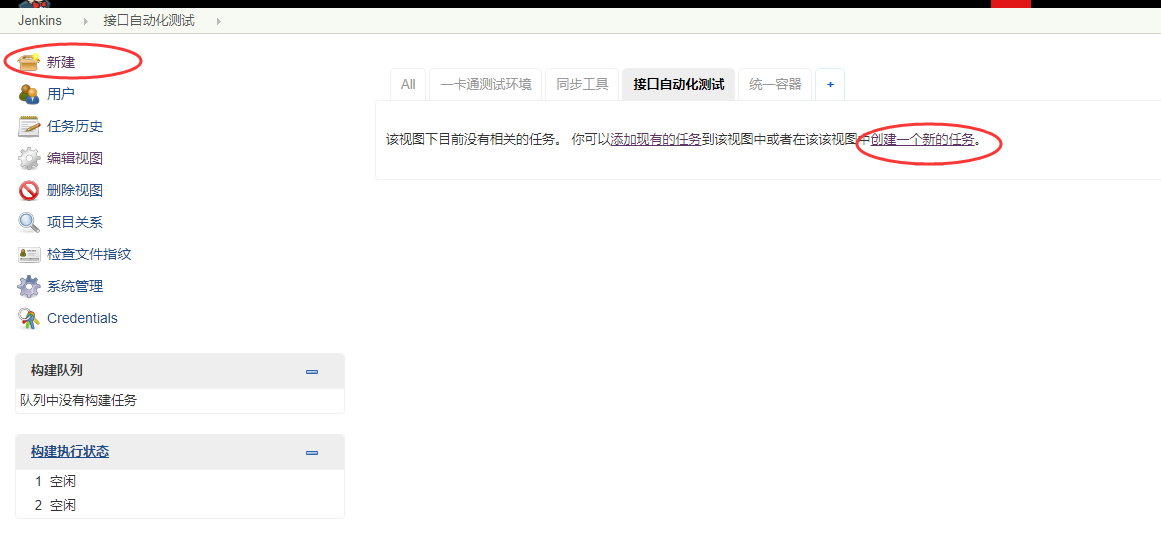
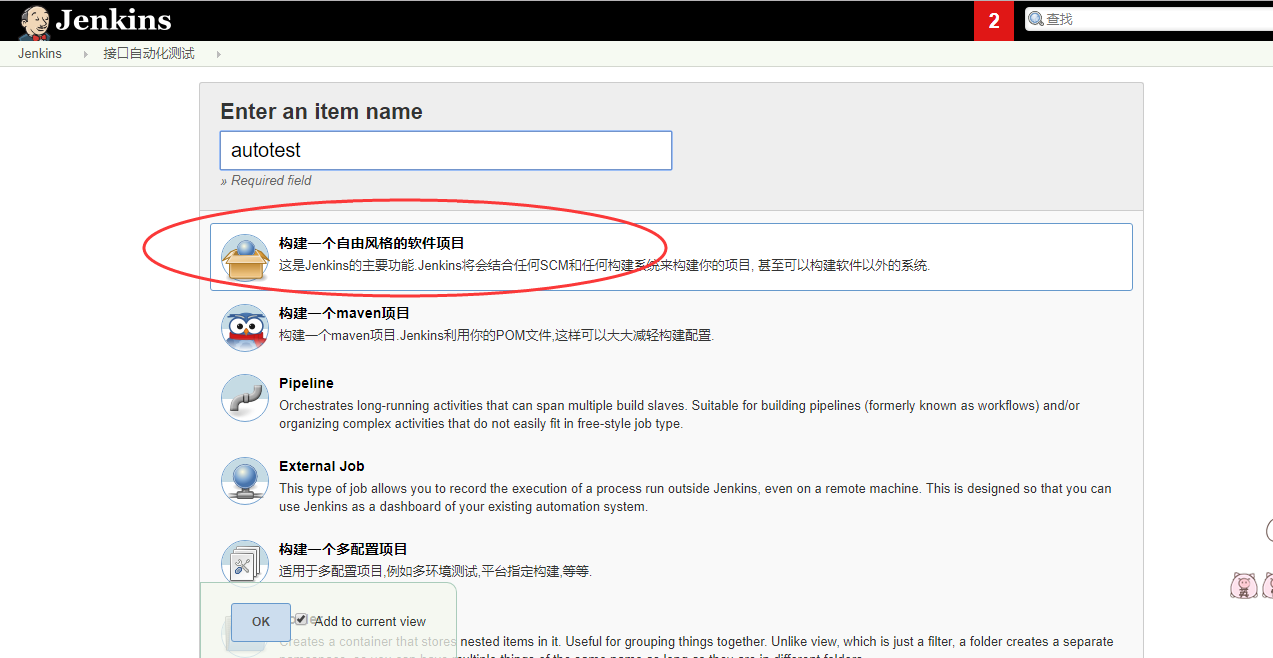
2.选择构建触发器,根据时间点,每天到点进行自动触发构建

3.输入构建命令
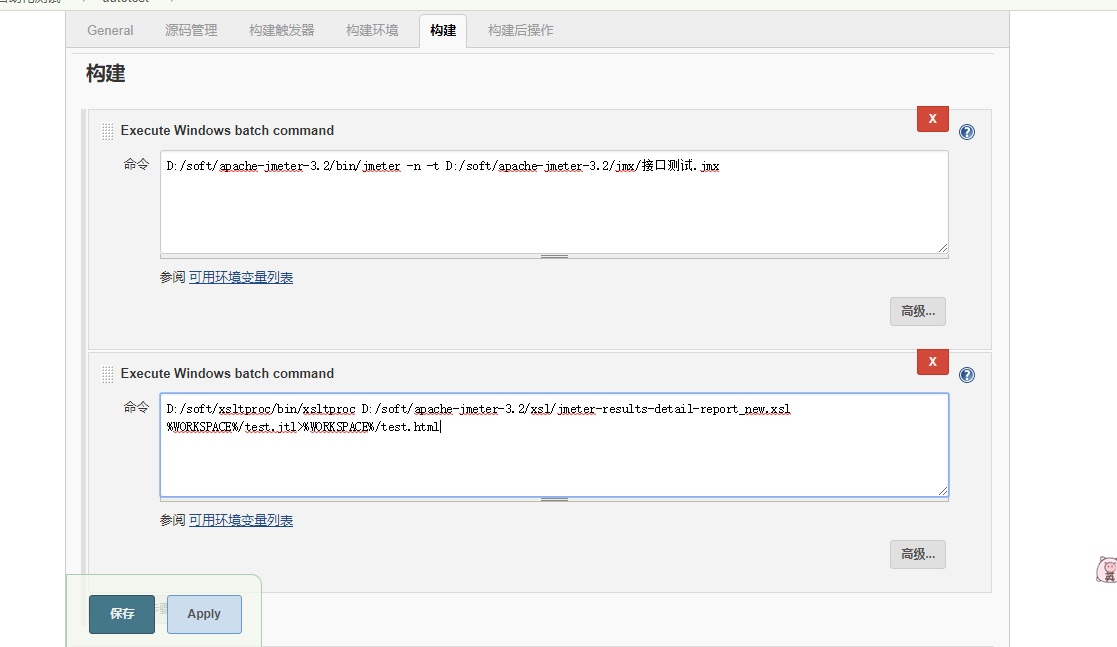
(1)D:/soft/apache-jmeter-3.2/bin/jmeter -n -t D:/soft/apache-jmeter-3.2/jmx/接口测试.jmx
这一句是通过cmd命令调用jmeter程序,执行jmeter的jmx自动化脚本;
(2)D:/soft/xsltproc/bin/xsltproc D:/soft/apache-jmeter-3.2/xsl/jmeter-results-detail-report_new.xsl %WORKSPACE%/test.jtl>%WORKSPACE%/test.html
这一句是调用xslproc程序,通过jmeter-results-detail-report_new.xsl模板,将jtl文件转换为html报告文件;
4.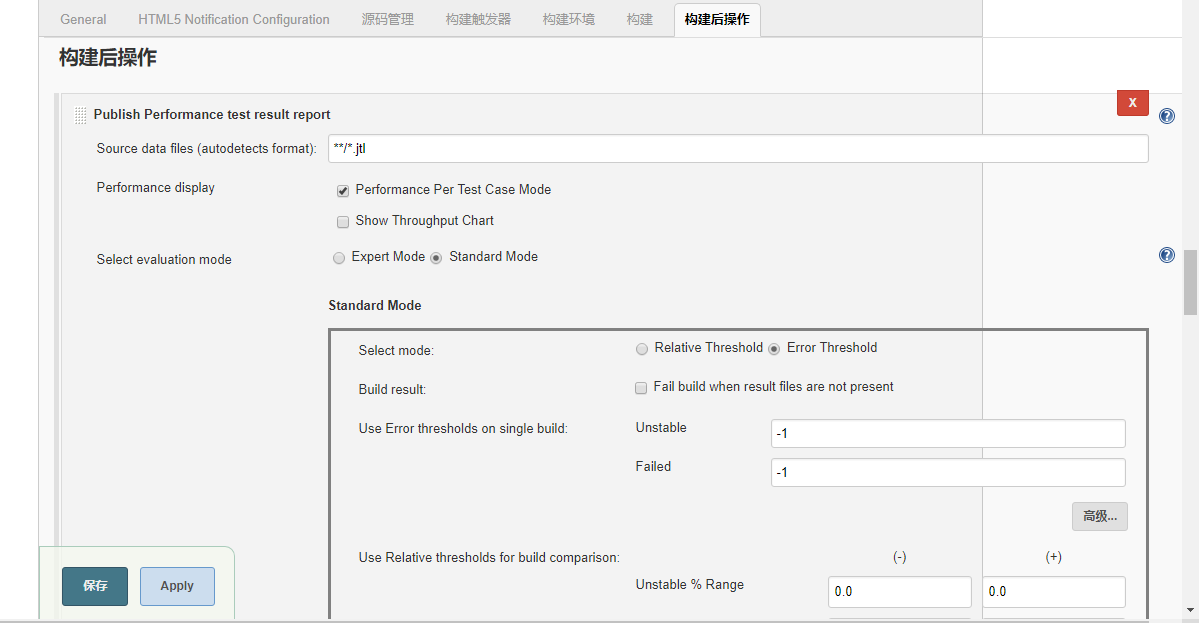
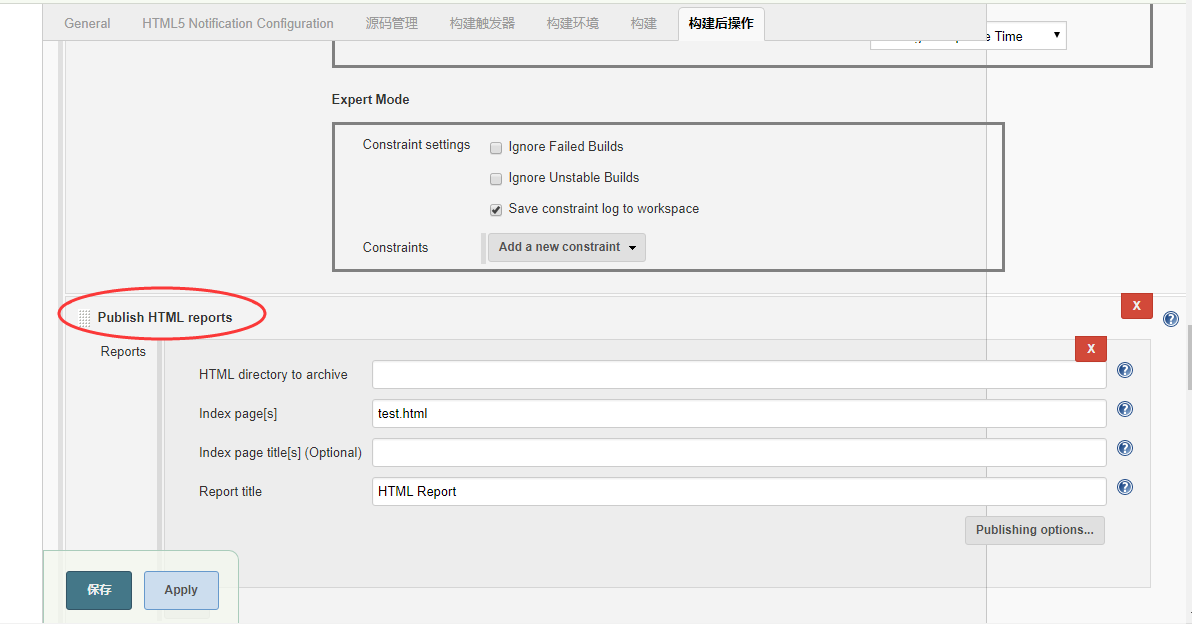
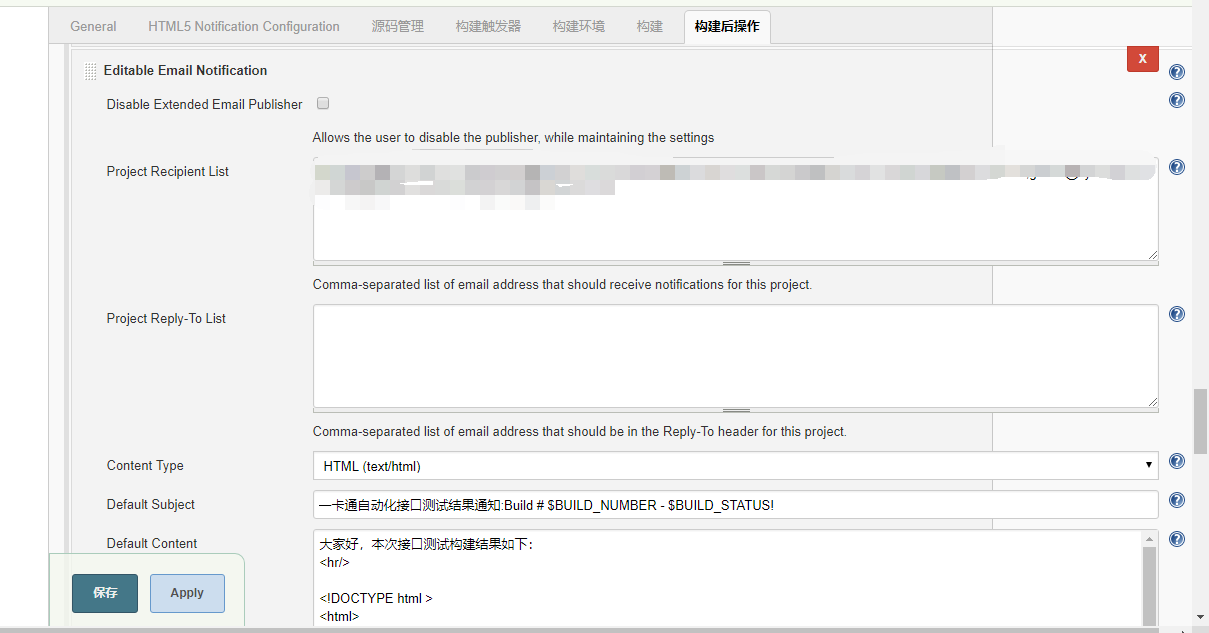
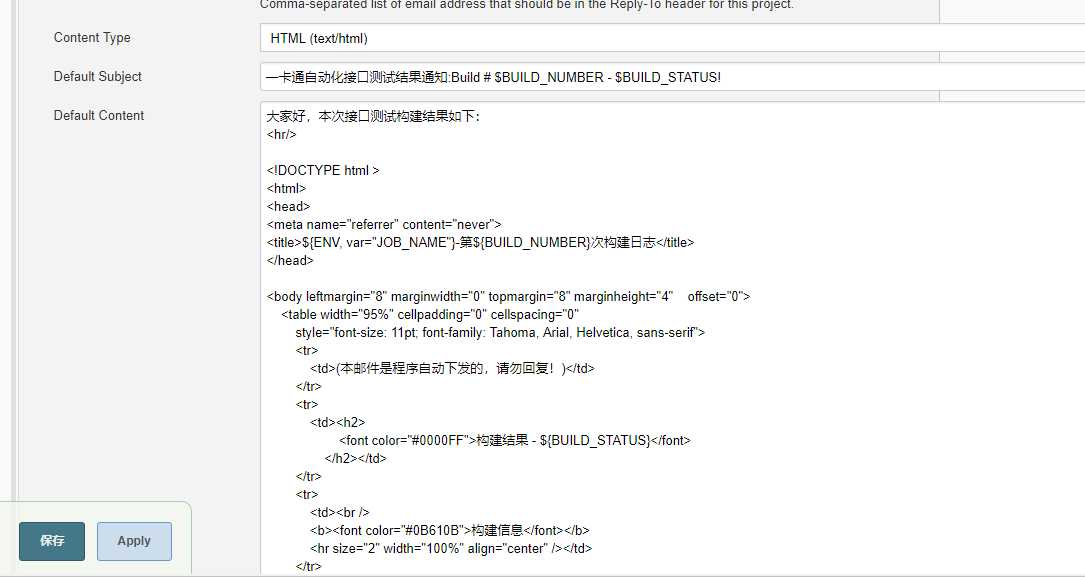
邮件的格式代码如下:
大家好,本次接口测试构建结果如下:
<hr/> <!DOCTYPE html >
<html>
<head>
<meta name="referrer" content="never">
<title>${ENV, var="JOB_NAME"}-第${BUILD_NUMBER}次构建日志</title>
</head> <body leftmargin="8" marginwidth="0" topmargin="8" marginheight="4" offset="0">
<table width="95%" cellpadding="0" cellspacing="0"
style="font-size: 11pt; font-family: Tahoma, Arial, Helvetica, sans-serif">
<tr>
<td>(本邮件是程序自动下发的,请勿回复!)</td>
</tr>
<tr>
<td><h2>
<font color="#0000FF">构建结果 - ${BUILD_STATUS}</font>
</h2></td>
</tr>
<tr>
<td><br />
<b><font color="#0B610B">构建信息</font></b>
<hr size="2" width="100%" align="center" /></td>
</tr>
<tr>
<td>
<ul>
<li>项目名称 : ${PROJECT_NAME}</li>
<li>构建编号 : 第${BUILD_NUMBER}次构建</li>
<li>触发原因: ${CAUSE}</li>
<li>构建日志: <a href="${BUILD_URL}console">${BUILD_URL}console</a></li>
<li>构建 Url : <a href="${BUILD_URL}">${BUILD_URL}</a></li>
<li>工作目录 : <a href="${PROJECT_URL}ws">${PROJECT_URL}ws</a></li>
<li>项目 Url : <a href="${PROJECT_URL}">${PROJECT_URL}</a></li>
</ul>
</td>
</tr>
<tr>
<td><b><font color="#0B610B">Changes Since Last
Successful Build:</font></b>
<hr size="2" width="100%" align="center" /></td>
</tr>
<tr>
<td>
<ul>
<li>历史变更记录 : <a href="${PROJECT_URL}changes">${PROJECT_URL}changes</a></li>
</ul> ${CHANGES_SINCE_LAST_SUCCESS,reverse=true, format="Changes for Build #%n:<br />%c<br />",showPaths=true,changesFormat="<pre>[%a]<br />%m</pre>",pathFormat=" %p"}
</td>
</tr>
<tr>
<td><b>Failed Test Results</b>
<hr size="2" width="100%" align="center" /></td>
</tr>
<tr>
<td><pre
style="font-size: 11pt; font-family: Tahoma, Arial, Helvetica, sans-serif">$FAILED_TESTS</pre>
<br /></td>
</tr>
</table> </body>
</html>
<b>${FILE,path="D:/jenkins/workspace/test/test.html"}</b>
以上是jenkins的所有设置
5.jenkins的版本太低的话,可能存在需要手动下载jenkins插件
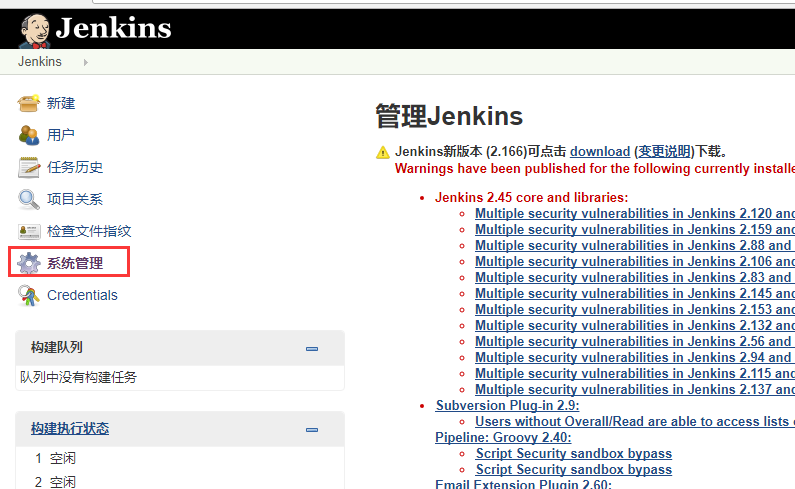
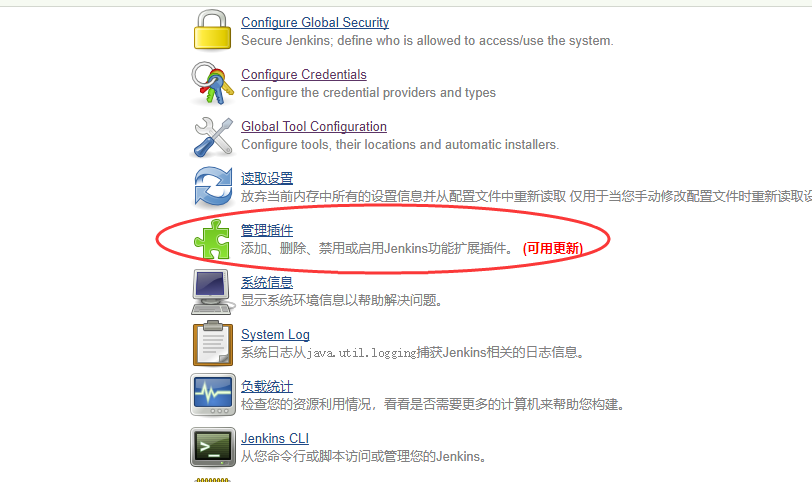

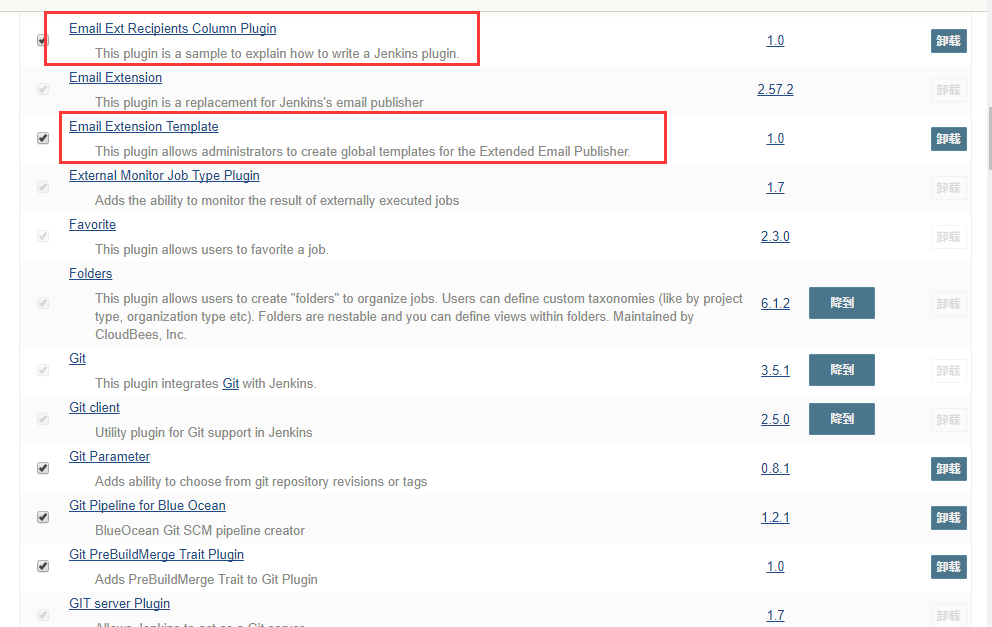

最后,附上模板代码给大家~
<xsl:stylesheet xmlns:xsl="http://www.w3.org/1999/XSL/Transform" version="1.0"> <!--
Licensed to the Apache Software Foundation (ASF) under one or more
contributor license agreements. See the NOTICE file distributed with
this work for additional information regarding copyright ownership.
The ASF licenses this file to You under the Apache License, Version 2.0
(the "License"); you may not use this file except in compliance with
the License. You may obtain a copy of the License at http://www.apache.org/licenses/LICENSE-2.0 Unless required by applicable law or agreed to in writing, software
distributed under the License is distributed on an "AS IS" BASIS,
WITHOUT WARRANTIES OR CONDITIONS OF ANY KIND, either express or implied.
See the License for the specific language governing permissions and
limitations under the License.
--> <!--
Stylesheet for processing 2.1 output format test result files
To uses this directly in a browser, add the following to the JTL file as line 2:
<?xml-stylesheet type="text/xsl" href="../extras/jmeter-results-detail-report_21.xsl"?>
and you can then view the JTL in a browser
--> <xsl:output method="html" indent="yes" encoding="GB18030" doctype-public="-//W3C//DTD HTML 4.01 Transitional//EN" /> <!-- Defined parameters (overrideable) <td bgcolor="#ff00ff"> -->
<xsl:param name="showData" select="'y'"/>
<xsl:param name="titleReport" select="'接口测试'"/> <xsl:template match="testResults">
<html > <head>
<title><xsl:value-of select="$titleReport" /></title>
<style type="text/css"> body {
font:normal 95% verdana,arial,helvetica;
color:#000000;
}
table tr td, table tr th {
font-size: 95%;
}
table.details tr th{
word-wrap:break-word;
color: #ffffff;
font-weight: bold;
text-align:center;
background:#2674a6; }
table.details tr td{
width: 400px;
word-wrap:break-word;
background:#eeeee0; }
table{
table-layout:fixed ;
}
h1 {
margin: 0px 0px 5px; font: 165% verdana,arial,helvetica
}
h2 {
margin-top: 1em; margin-bottom: 0.5em; font: bold 125% verdana,arial,helvetica
}
h3 {
margin-bottom: 0.5em; font: bold 115% verdana,arial,helvetica
}
.Failure {
font-weight:bold; color:red;
} img
{
border-width: 0px;
} .expand_link
{
position:absolute;
right: 0px;
width: 27px;
top: 1px;
height: 27px;
} .page_details
{
display: none;
} /* .page_details_expanded
{
display: block;
displayhide this definition from IE5/6: table-row;
} */ </style>
<script language="JavaScript"><![CDATA[
function expand(details_id)
{ document.getElementById(details_id).className = "page_details_expanded";
} function collapse(details_id)
{ document.getElementById(details_id).className = "page_details";
} function change(details_id)
{
if(document.getElementById(details_id+"_image").src.match("expand"))
{
document.getElementById(details_id+"_image").src = "collapse.png";
expand(details_id);
}
else
{
document.getElementById(details_id+"_image").src = "expand.png";
collapse(details_id);
}
}
]]></script>
</head>
<body > <xsl:call-template name="pageHeader" />
<xsl:call-template name="myresult" />
<xsl:call-template name="summary" />
<hr size="1" width="75%" align="center" /> <xsl:call-template name="pagelist" />
<hr size="1" width="75%" align="center" /> <xsl:call-template name="detail" /> </body> </html>
</xsl:template> <xsl:template name="pageHeader">
<h1><xsl:value-of select="$titleReport" /></h1>
<table width="100%">
<tr>
<td align="left">Date report:</td>
<td align="right">from 一卡通</td>
</tr>
</table>
<hr size="1" />
</xsl:template> <xsl:template name="myresult"> <xsl:variable name="allFailCount" select="count(/testResults/*[attribute::s='false'])" /> <xsl:if test="$allFailCount = '0'">
<h2>测试结果:成功</h2>
</xsl:if>
<xsl:if test="$allFailCount > '0'">
<h2 bgcolor="#ff00ff">测试结果:失败</h2>
<h2 bgcolor="#ff00ff">失败个数:<xsl:value-of select="count(/testResults/*[attribute::s='false'])"/></h2> </xsl:if> </xsl:template> <xsl:template name="summary">
<h2>报告概况</h2>
<table align="center" class="details" border="0" cellpadding="5" cellspacing="2" width="95%">
<tr valign="top">
<th>用例总数</th>
<th>失败数</th>
<th>成功率</th>
<th>平均响应时间</th>
</tr>
<tr valign="top">
<xsl:variable name="allCount" select="count(/testResults/*)" />
<xsl:variable name="allFailureCount" select="count(/testResults/*[attribute::s='false'])" />
<xsl:variable name="allSuccessCount" select="count(/testResults/*[attribute::s='true'])" />
<xsl:variable name="allSuccessPercent" select="$allSuccessCount div $allCount" />
<xsl:variable name="allTotalTime" select="sum(/testResults/*/@t)" />
<xsl:variable name="allAverageTime" select="$allTotalTime div $allCount" />
<xsl:variable name="allMinTime">
<xsl:call-template name="min">
<xsl:with-param name="nodes" select="/testResults/*/@t" />
</xsl:call-template>
</xsl:variable>
<xsl:variable name="allMaxTime">
<xsl:call-template name="max">
<xsl:with-param name="nodes" select="/testResults/*/@t" />
</xsl:call-template>
</xsl:variable>
<xsl:attribute name="class">
<xsl:choose>
<xsl:when test="$allFailureCount > 0">Failure</xsl:when>
</xsl:choose>
</xsl:attribute>
<td align="center">
<xsl:value-of select="$allCount" />
</td>
<td align="center">
<xsl:value-of select="$allFailureCount" />
</td>
<td align="center">
<xsl:call-template name="display-percent">
<xsl:with-param name="value" select="$allSuccessPercent" />
</xsl:call-template>
</td>
<td align="center">
<xsl:call-template name="display-time">
<xsl:with-param name="value" select="$allAverageTime" />
</xsl:call-template>
</td> </tr>
</table>
</xsl:template> <xsl:template name="pagelist">
<h2>详细情况</h2>
<table align="center" class="details" border="0" cellpadding="5" cellspacing="2" width="95%">
<tr valign="top">
<th width="50%">功能模块</th>
<th>检查次数</th>
<th>失败数</th>
<th>成功率</th>
<th>平均响应时间</th> </tr>
<xsl:for-each select="/testResults/*[not(@tn = preceding::*/@tn)]">
<xsl:variable name="label" select="@tn" />
<xsl:variable name="count" select="count(../*[@tn = current()/@tn])" />
<xsl:variable name="failureCount" select="count(../*[@tn = current()/@tn][attribute::s='false'])" />
<xsl:variable name="successCount" select="count(../*[@tn = current()/@tn][attribute::s='true'])" />
<xsl:variable name="successPercent" select="$successCount div $count" />
<xsl:variable name="totalTime" select="sum(../*[@tn = current()/@tn]/@t)" />
<xsl:variable name="averageTime" select="$totalTime div $count" />
<xsl:variable name="minTime">
<xsl:call-template name="min">
<xsl:with-param name="nodes" select="../*[@tn = current()/@tn]/@t" />
</xsl:call-template>
</xsl:variable>
<xsl:variable name="maxTime">
<xsl:call-template name="max">
<xsl:with-param name="nodes" select="../*[@tn = current()/@tn]/@t" />
</xsl:call-template>
</xsl:variable> <tr valign="top">
<xsl:attribute name="class">
<xsl:choose>
<xsl:when test="$failureCount > 0">Failure</xsl:when>
</xsl:choose>
</xsl:attribute>
<td>
<xsl:if test="$failureCount > 0">
<a><xsl:attribute name="href">#<xsl:value-of select="$label" /></xsl:attribute>
<xsl:value-of select="$label" />
</a>
</xsl:if>
<xsl:if test="0 >= $failureCount">
<xsl:value-of select="$label" />
</xsl:if>
</td>
<td align="center">
<xsl:value-of select="$count" />
</td>
<td align="center">
<xsl:value-of select="$failureCount" />
</td>
<td align="center">
<xsl:call-template name="display-percent">
<xsl:with-param name="value" select="$successPercent" />
</xsl:call-template>
</td>
<td align="center">
<xsl:call-template name="display-time">
<xsl:with-param name="value" select="$averageTime" />
</xsl:call-template>
</td> </tr> </xsl:for-each>
</table>
</xsl:template> <xsl:template name="detail">
<xsl:variable name="allFailureCount" select="count(/testResults/*[attribute::s='false'])" /> <xsl:if test="$allFailureCount > 0">
<h2>Failure Detail</h2> <xsl:for-each select="/testResults/*[not(@lb = preceding::*/@lb)]">
<xsl:variable name="failureCount" select="count(../*[@lb = current()/@lb][attribute::s='false'])" />
<xsl:if test="$failureCount > 0">
<xsl:for-each select="/testResults/*[@lb = current()/@lb][attribute::s='false']">
<h3><xsl:value-of select="@tn" />---<xsl:value-of select="@lb" /><a><xsl:attribute name="name"><xsl:value-of select="@tn" /></xsl:attribute></a></h3> <table align="center" class="details" border="0" cellpadding="5" cellspacing="2" width="95%">
<tr valign="top">
<th>http请求</th>
<th>失败详细信息</th>
<xsl:if test="$showData = 'y'">
<th>响应数据</th>
</xsl:if>
</tr> <tr>
<td><xsl:value-of select="java.net.URL" /> </td>
<td><xsl:value-of select="assertionResult/failureMessage" /></td>
<xsl:if test="$showData = 'y'">
<td><xsl:value-of select="responseData" /></td>
</xsl:if>
</tr> </table>
</xsl:for-each>
</xsl:if> </xsl:for-each>
</xsl:if>
</xsl:template> <xsl:template name="min">
<xsl:param name="nodes" select="/.." />
<xsl:choose>
<xsl:when test="not($nodes)">NaN</xsl:when>
<xsl:otherwise>
<xsl:for-each select="$nodes">
<xsl:sort data-type="number" />
<xsl:if test="position() = 1">
<xsl:value-of select="number(.)" />
</xsl:if>
</xsl:for-each>
</xsl:otherwise>
</xsl:choose>
</xsl:template> <xsl:template name="max">
<xsl:param name="nodes" select="/.." />
<xsl:choose>
<xsl:when test="not($nodes)">NaN</xsl:when>
<xsl:otherwise>
<xsl:for-each select="$nodes">
<xsl:sort data-type="number" order="descending" />
<xsl:if test="position() = 1">
<xsl:value-of select="number(.)" />
</xsl:if>
</xsl:for-each>
</xsl:otherwise>
</xsl:choose>
</xsl:template> <xsl:template name="display-percent">
<xsl:param name="value" />
<xsl:value-of select="format-number($value,'0.00%')" />
</xsl:template> <xsl:template name="display-time">
<xsl:param name="value" />
<xsl:value-of select="format-number($value,'0 ms')" />
</xsl:template> </xsl:stylesheet>
模板的截图如下:
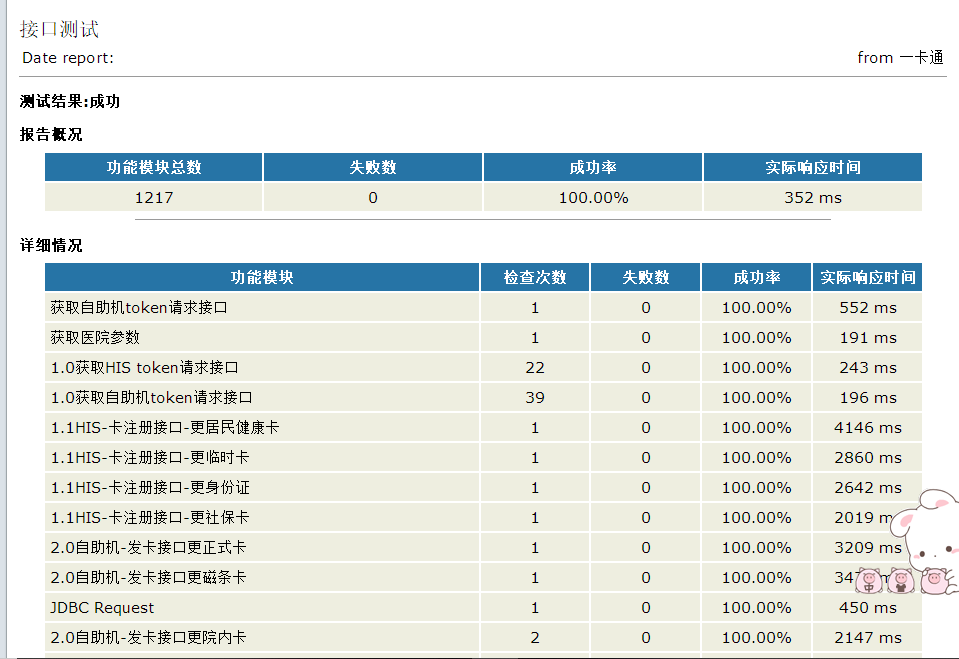
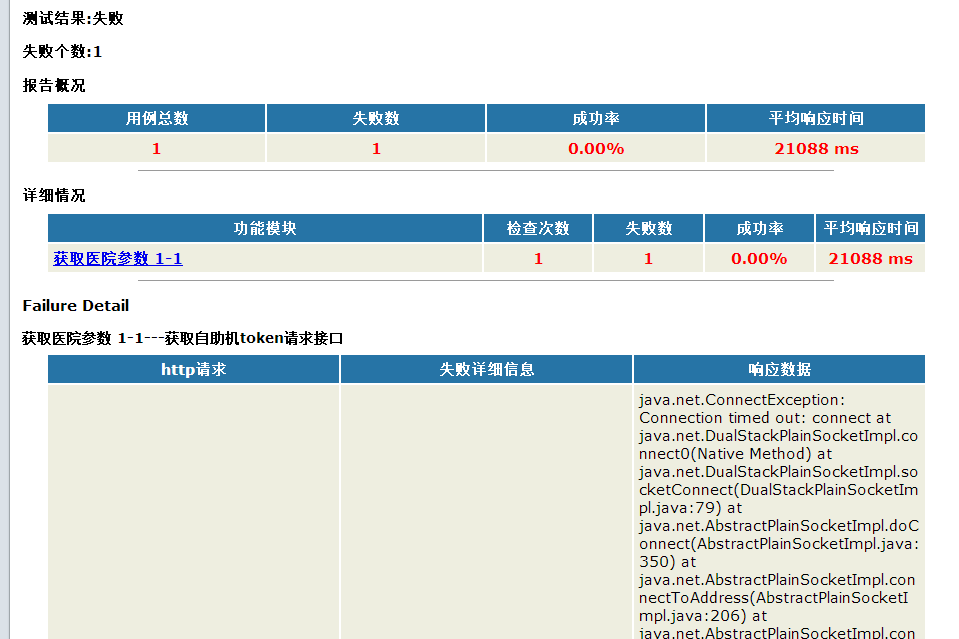
jmeter接口自动化部署jenkins教程的更多相关文章
- Jenkins+Ant+Jmeter接口自动化集成测试实例
Jenkins+Ant+Jmeter接口自动化集成测试实例 一.Jenkins安装配置 1.安装配置JDK1.6+环境变量: 2.下载jenkins.war,放入C:\jenkins目录下,目录位置随 ...
- 转载:python + requests实现的接口自动化框架详细教程
转自https://my.oschina.net/u/3041656/blog/820023 摘要: python + requests实现的接口自动化框架详细教程 前段时间由于公司测试方向的转型,由 ...
- python + requests实现的接口自动化框架详细教程
前段时间由于公司测试方向的转型,由原来的web页面功能测试转变成接口测试,之前大多都是手工进行,利用postman和jmeter进行的接口测试,后来,组内有人讲原先web自动化的测试框架移驾成接口的自 ...
- 第9期《jmeter接口自动化实战》零基础入门!
2019年 第9期<jmeter接口自动化实战>课程,12月6号开学! 上课方式:QQ群视频在线教学 本期上课时间:12月6号-1月18号,每周五.周六晚上20:00-22:00 报名费: ...
- JMeter接口自动化发包与示例
JMeter接口自动化发包与示例 近期需要完成对于接口的测试,于是了解并简单做了个测试示例,看了看这款江湖上声名远播的强大的软件-Jmeter靠不靠谱. 官网:https://jmeter.apach ...
- Jenkins+ant+Jmeter接口自动化框架搭建
工具准备 JDK: jdk1.8.0_111 Ant: apache-ant-1.9.9 Jmeter: apache-jmeter-3.1 Jenkins: jenkins-2.7.4 JDK安装 ...
- Jmeter 接口自动化-脚本数据分离实例
一. 背景: 为了让大家更加的了解Jmeter,并且使用起来游刃有余.这篇我们主要讲一下,如何优雅的使用Jmeter一步步的实现接口自动化,完成脚本与数据分离,把可能对Jmeter脚本的维护转移到c ...
- jmeter接口自动化集成
接口自动化集成 一.jmeter基础学习 1.博客 :http://www.cnblogs.com/fnng/category/345478.html 2.博客 http://www.cnblo ...
- jmeter接口自动化和性能学习目录
目录黑色代表未完成的,绿色代表已完成的文章.目录的作用的为了引导和总结自己的学习,也是为了更好的分享给大家. 一.接口自动化 jmeter解决登录token获取 jmeter五种提取器 之 正则表达 ...
随机推荐
- ckeditor 实现ctrl+v粘贴图片并上传、word粘贴带图片
公司做的项目需要用到文本上传功能. Chrome+IE默认支持粘贴剪切板中的图片,但是我要粘贴的文章存在word里面,图片多达数十张,我总不能一张一张复制吧? 我希望打开文档doc直接复制粘贴到富文本 ...
- 2018-03-13 HTTP Socket TCP学习
协议学习: https://www.jianshu.com/p/a5410f895d6b https://www.jianshu.com/p/42260a2575f8 实际例子: nano实际例子,和 ...
- (01背包)Buy the souvenirs (hdu 2126)
http://acm.hdu.edu.cn/showproblem.php?pid=2126 Buy the souvenirs Time Limit: 10000/1000 MS (Java/Oth ...
- java poi 合并单元格
java poi 合并单元格 2017年03月29日 16:39:01 翠烟你懊恼 阅读数:26561 版权声明:本文为博主原创文章,未经博主允许不得转载. https://blog.csdn.n ...
- express 错误处理
原谅我的无知,之前学习express时,没想过需要错误处理.app.js也没认真看. 现在做具体的项目时,需要考虑到出错的情况. 其实有两种: 1.nodejs是单线程,如果挂掉了,网站就会崩溃,需要 ...
- zoj3820
题意:给定一个树,找出两个点,使得其他点到最近的点的距离最小 思路: 牡丹江站的B题..可惜当时坑的不大对,最后也没写完.. 1.题解方法: 基于一个结论,答案一定在直径上(证明我不会).. 那么,可 ...
- shell 命令 mkdir -p
开发中我们会遇到嵌套创建文件目录的需要,这时需要用到 mkdir -p 比如我要在本地嵌套创建 /Users/dairui/Downloads/zookeeper/dataLogDir目录 直接使用 ...
- verilog中defparam的用法 (verilog调用底层模块(只改变)参数的传递)
当一个模块引用另外一个模块时,高层模块可以改变低层模块用parameter定义的参数值,改变低层模块的参数值可采用以下两种方式: 1)defparam 重定义参数 语法:defparam path_n ...
- [php-dom] php-dom使用注意事项
/* 注意事项: 1. 在loadHTML之前,应该将内容转义为UTF-8编码的,这样子避免出现entity等等的报错: 2. 已经使用了php函数htmlspecialchars()转换的html实 ...
- 关于能量场和力场弯曲空间的实验证明 EXPERIMENTAL PROOF ON THE BENDING SPACE OF ENERGY FIELD AND FORCE FIELD
前文提到,F = ma, E = mc^2,并且等效是传递的,等效概念具有同属性.所以不止能量,力场也可以弯曲空间. 实验:某人被头顶上方的电站10几万伏的设备吸收,烧毁双臂. (虽然这个实验不应具有 ...
